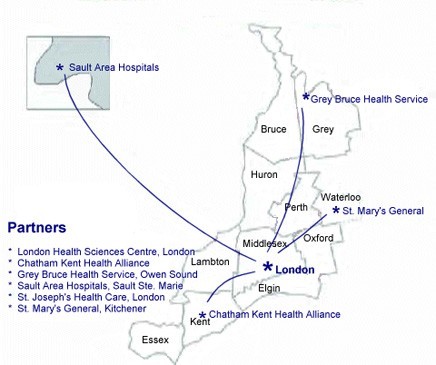Ophthalmic Imaging Network
The Ophthalmic Imaging Network is a regional collaboration among three centers in Southwestern Ontario and one centre in Sault Ste. Marie to improve regional access to diagnostic fluorescein angiography to enable, through screening processes, earlier diagnoses of retinal diseases. The four centers are linked via the Internet and digital imaging acquisition cameras and software. Pictures of a patients eye are taken in the satellite hospital and London acts as the consultant site, having a retinal specialist review the pictures and report the findings. The patients no longer have to travel to London to receive diagnostic fluorescein angiography. Care is provided closer to home.
The Network will also serve as the foundation for the establishment of a Clinical Research Centre where research will be conducted into new modes of therapy and new forms of early detection and intervention.
Partners
- Chatham Kent Health Alliance
- London Health Sciences Centre
- Grey Bruce Health Service, Owen Sound
- Sault Area Hospitals, Sault Ste. Marie
- St. Mary's General, Kitchener
Key Benefits of Ophthalmic Imaging Network
- Improved ability to perform patient screening by providing timely access of patients to retinal photography and fluorescein angiography within their home region.
- Improved ability to identify and manage patients with retinal disease which would benefit from early treatment.
- Improve the ability to follow patients after completion of treatment to detect recurrence.
- Improve patient satisfaction and treatment outcomes throughout the region through early detection and treatment.
Geography
London serves as the referral centre for patients with retinal diseases from a wide geographic area, stretching from Windsor in the west to Guelph in the east and from the shore of Lake Erie in the south to Sault Ste. Marie in the north. This catchment area represents a population of about 1.5 million people. This very large and geographically diverse referral population poses great challenges in the management of retinal disease, like diabetes and macular degeneration, where patients often require repeat examinations and fluorescein angiography as the diseases are followed over prolonged periods of time. The satellite sites allows the provision of the diagnostic fluorescein angiography in specific regions of the Southwest.

It is important that patients and their local ophthalmologists have the appropriate information about a diagnosis--particularly in those cases where monitoring a situation is the preferred approach. Given current and projected patient volumes, the ability to pre-screen patients in a timely manner and to select those requiring urgent intervention is also critical. With the availability of digital technology, the image of the patient's eye is now transferable.
Eye Diseases
The two main retinal diseases supported by the network:
- Age related macular degeneration is the most common cause of severe vision loss and legal blindness among people over 65. According to CNIB, in Canada an additional 10000 people become legally blind each year as a result of macular degeneration. Located in the centre of the retina, the sensitive macula provides us with sight in the centre of our field of vision. When we look directly at something, the macula allows us to see the fine details necessary for driving, reading, recognizing faces, and doing close work.
- Diabetic retinopathy is a complication of diabetes caused by changes in the blood vessels of the eye. When blood vessels in the retina are damaged, they may leak fluid or blood, and grow fragile, brush like branches and scar tissue. This can blur of distort the images that the retina sends to the brain. Diabetics are 25 times more at risk for blindness than the general population.








